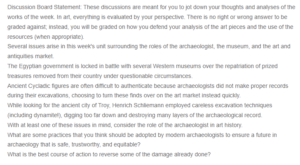The Changing Role of the Archaeologist
When it comes to archeological sites and artifacts, one major challenge is destruction. An example of archaeological site destruction is by amateur archaeologist Heinrich Schliemann, who basically destroyed huge portions of an archaeological site and its records in his search for the ancient city of Troy (Kleiner, 2015). Nevertheless, there are some solutions to such problems today. To begin with, any archaeological remains found must be mandated to a team of experts, including archaeological professionals like archaeological conservators and bio-archaeologists, among others. In the same way that a patient undergoing surgery has multiple medical professionals, all with different specialties, to cater to the patient, the same case should apply to archaeology. As a result, this will ensure that any deviation from the mandate excavation procedure will lead to prosecution on the basis of the destruction of property, the same way a patient would if there were no, say, attending anesthetists during the patient’s surgery. Also, it is worth noting that these professionals are bound by a code of ethics that ensures that they will protect any archaeological finding they come across (González-Ruibal 2018).
Moreover, the best course of action to help reverse any damage done to artifacts or archaeological sites is restoration. Basically, restoration involves trying to reverse the damage by reassembling the existing parts to try and create what it was like before the damage (Vohrer et al., 2001). Notably, restoration does not involve any introduction of new materials. Another method that can be used to reverse damage to archaeological artifacts is reconstruction (Tschudi, 2012). Essentially, the reconstruction process involves the introduction of new materials, mostly plaster.
References
González-Ruibal, A. (2018). Ethics of archaeology. Annual Review of Anthropology, 47, 345-360.
Kleiner, F. S. (2015). Gardner’s Art through the Ages: A Global History, Volume I (Vol. 1). Cengage Learning.
Tschudi, V. P. (2012). Plaster empires: Italo Gismondi’s model of Rome. Journal of the Society of Architectural Historians, 71(3), 386-403.
Vohrer, U., Trick, I., Bernhardt, J., Oehr, C., & Brunner, H. (2001). Plasma treatment—An increasing technology for paper restoration? Surface and Coatings Technology, 142, 1069-1073.
ORDER A PLAGIARISM-FREE PAPER HERE
We’ll write everything from scratch
Question

The Changing Role of the Archaeologist
Discussion Board Statement: These discussions are meant for you to jot down your thoughts and analyses of the works of the week. In art, everything is evaluated by your perspective. There is no right or wrong answer to be graded against; instead, you will be graded on how you defend your analysis of the art pieces and the use of the resources (when appropriate).
Several issues arise in this week’s unit surrounding the roles of the archaeologist, the museum, and the art and antiquities market.
The Egyptian government is locked in battle with several Western museums over the repatriation of prized treasures removed from their country under questionable circumstances.
Ancient Cycladic figures are often difficult to authenticate because archaeologists did not make proper records during their excavations, choosing to turn these finds over on the art market instead quickly.
While looking for the ancient city of Troy, Henrich Schliemann employed careless excavation techniques (including dynamite!), digging too far down and destroying many layers of the archaeological record.
With at least one of these issues in mind, consider the role of the archaeologist in art history.
What are some practices that you think should be adopted by modern archaeologists to ensure a future in archaeology that is safe, trustworthy, and equitable?
What is the best course of action to reverse some of the damage already done?

